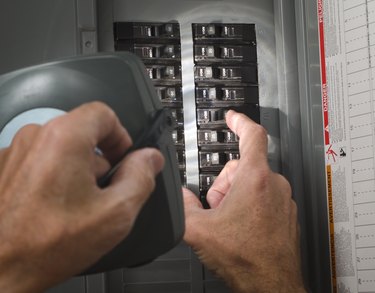
Most homes have one or more double-pole circuit breakers in the electrical panel. These breakers control 240-volt circuits that power large appliances, such as electric water heaters, dryers, and ranges. But how exactly do they work?
Essentially, a double breaker is basically an interconnected set of two single-pole breakers. Each one snaps onto a different hot bus in the panel, and because they're interconnected, they trip at the same time. Double-pole breakers are usually rated for current in a range between 30 and 60 amps.
Video of the Day
Video of the Day
How the Panel Receives Electricity
Each circuit in the house is wired to the electrical panel, which is the point at which the power enters the house from the transmission line. A transformer mounted on the power pole steps the line voltage down to 240 volts, more or less. Wire resistance and other factors often reduce this to 220 volts. This energy comes to the house in the form of two hot wires with the transformer output voltage between them. Each hot wire is connected to a hot bus bar in the panel, and a third bus – the neutral – is connected to the transformer by a third wire. The voltage between each hot bus and the neutral bus is 120 volts, while the voltage between the two hot buses remains at 240 volts.
How a Circuit Breaker Works
A number of manufacturers produce electrical panels, and each one designs the panel in such a way to accept the breakers they manufacture. A 120-volt breaker typically clips onto one of the bus bars when you snap it into place. When you connect a hot circuit wire to the breaker and the neutral wire from that circuit to the neutral bus, the voltage in the circuit is 120 volts. The breaker is designed to detect current surges, such as those caused by overloads or short circuits, and to automatically shut off when one occurs. Single-pole breakers are usually rated for 15 or 20 amps and will trip when the current exceeds their rating. The purpose of the breaker is to prevent electrocution, fire and damage to electrical equipment.
Double-Pole Breakers Connect Hot Buses
A double-pole breaker is basically a pair of single-pole breakers stacked on top of each other. They're arranged so that the first breaker clips onto one hot bus while the second clips onto the other hot bus when you snap the breaker into place. An internal trip mechanism ensures that both wires are disconnected from the bus at the same time.
The circuit that this type of breaker controls has to have two hot wires. One of the wires, which is usually black, attaches to one breaker while the other, which is usually red, attaches to the other. This arrangement makes the voltage between the hot wires 240 volts. A white wire connected to the neutral bus completes the circuit, and a bare or green wire connected to the ground bus protects it.
Because double-pole breakers control circuits that supply more power than single-pole circuits, they're rated for higher currents. The rating you should use depends on the appliance. Window air conditioners and water heaters typically require 30-amp breakers, while ranges and electric heating systems need 50- and even 60-amp breakers.